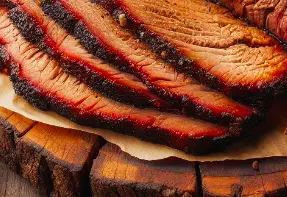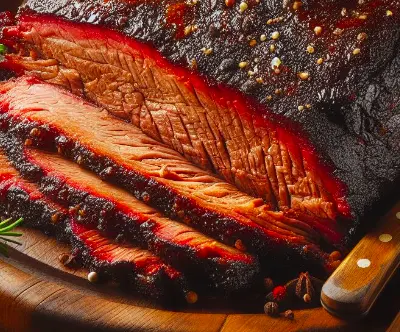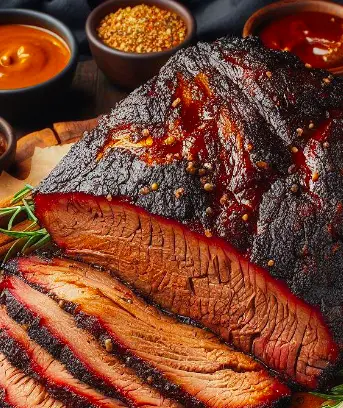Cooking a 15-pound brisket is a culinary endeavor that requires patience and precision. We will be exploring how long to cook a 15 lb brisket in this article. My experience has taught me that the key to a perfect brisket lies in both the cooking time and temperature control. Achieving that juicy and flavorful finish is all about slow cooking the meat at a low temperature, which allows the connective tissues to break down and become tender. A general rule of thumb is to cook a brisket for approximately 1 to 1.5 hours per pound, but this is only a guideline, as the actual cooking time can vary based on factors such as meat thickness, fat content, and specific cooking temperatures.

Moreover, I’ve found that utilizing a meat thermometer is essential to ensure the brisket reaches the ideal internal temperature. I aim for an internal temp of about 195°F to 205°F, as this range typically signifies that the brisket is perfectly cooked. It’s crucial to remember that resting the brisket after cooking is just as important as the cooking process itself. Allowing it to rest, usually for an hour or more, helps redistribute the juices throughout the meat. This step ensures that my 15-pound brisket comes out tender, moist, and packed with flavor—a result that’s always well-received at any gathering.
Preparation to cook your 15 lb Brisket
When it comes to preparing a brisket, it’s crucial to start with selecting high-quality meat and properly trimming it to ensure even cooking and the best flavor.
Selecting the Best Beef 15 lb Brisket to Cook
I always look for a brisket with good marbling, as this will result in a more tender and flavorful cook. At the grocery store, Wagyu brisket is often renowned for its superior quality due to its intense marbling and richness. However, a high-grade choice or prime brisket is also a good option for achieving excellent results.
Trimming the Fat Cap and Hard Fat
Trimming the brisket is a step that can’t be skipped. I first remove the hard fat, as it doesn’t render well during cooking. Then, I carefully trim the fat cap to an even thickness—about 1/4 inch is ideal. This allows for enough fat to keep the brisket moist without preventing the smoke and heat from penetrating the meat. Remember, the fat side should be prepared thoughtfully to enhance the flavor and texture of your brisket.
Seasoning for Maximum Flavor

Seasoning a brisket is an art that enhances its natural flavors. A well-crafted dry rub penetrates the meat and infuses it with savory notes, creating a perfect balance that complements the brisket’s rich taste.
Creating a Dry Rub Mixture
To begin developing the flavors of the brisket, I start by mixing a balanced dry rub. I believe in a simple yet effective combination of brown sugar, for a touch of sweetness, and kosher salt, which acts as a flavor amplifier and tenderizer. Here’s a basic recipe I often use:
- 2 tablespoons of brown sugar
- 2 tablespoons of kosher salt
- 1 tablespoon of black pepper
- 1 tablespoon of garlic powder
- 1 tablespoon of chili powder
I make sure to blend these ingredients thoroughly in a bowl, ensuring the mixture is uniform to avoid any uneven flavor pockets.
Applying the Rub to the Meat Before You Cook the 15 lb Brisket
Next, with my brisket rub ready, I start with a clean, dry surface on the brisket, making sure there’s a thin layer of fat on top that will melt and impart succulence during cooking.
1. I generously coat the entire brisket with the dry rub. I use my hands to firmly press the mixture into the meat, both on the fat side and the meaty portions, to make sure the seasoning sticks properly.
2. I pay close attention not to overcoat it, which could overpower the meat’s natural flavors; the key is a balanced coverage.
By seasoning the brisket correctly, we set a foundation for a flavorful and aromatic final product that is sure to be mouthwatering.
Cooking Methods and Techniques

When preparing a 15 lb brisket, I employ specific methods and techniques to ensure it’s both tender and flavorful. Consistent low temperatures and a balance of smoke are crucial to the process.
Using a Pellet Smoker or Grill to Cook your 15 lb Brisket
Using my pellet smoker, I set it to maintain a low temperature which is vital for cooking brisket. The ideal range is between 225-250°F, a sweet spot that allows the meat to slowly tenderize over a long cook time. I make sure to use quality pellets to fuel the smoker, ensuring a steady temperature throughout the cook.
- Preheat the smoker: I always preheat my pellet smoker before placing the brisket inside.
- Positioning the brisket: It’s best to place the brisket fat-side up on the grill grate.
- Monitoring the Temperature: I frequently check the internal temperature using a meat probe to ensure perfection.
Smoke Flavor and Water Pan Usage
I enhance the smoke flavor by selecting hardwood pellets such as hickory or mesquite for their strong profiles. To maintain the moisture, I place a water pan directly on the grill or smoker, filled approximately halfway. This adds humidity to the cooking environment, which helps in preventing the brisket from drying out.
- Choosing Wood Pellets: Hickory and mesquite pellets are my go-to for bold smoke flavor.
- Water Pan Placement: I situate the water pan close to the heat source for maximum evaporation.
- Refilling the Water Pan: It’s important to keep the water pan filled, so I check on it hourly, refilling as needed.
Monitoring the Cooking Process
When cooking a 15 lb brisket, maintaining precise temperatures and utilizing a meat thermometer are crucial for achieving the perfect tenderness and flavor.
Managing Cooking Temperatures
I always emphasize the importance of keeping cooking temperatures consistent. For brisket, cooking at a lower temperature—around 225°F to 250°F—is ideal. This slow-cooking method allows the connective tissues to break down without drying out the meat, resulting in a juicy finish. A brisket that’s cooked at higher temperatures may be done sooner, but there’s a risk of it becoming tough or drying out.
- Optimal Temperature Range: 225°F – 250°F
- Total Cook Time: May vary, approximately 1 – 1.5 hours per pound
Remember, fluctuations in temperature can drastically alter the total cook time and the quality of the brisket.
Using a Meat Thermometer
A reliable meat thermometer is my best friend in the cooking process to ensure the brisket reaches the desired internal temperature. I insert the thermometer into the thickest part of the meat for an accurate reading. The goal internal temperature for brisket is around 195°F to 203°F; at this range, the brisket achieves maximum tenderness.
- Target Internal Temperature: 195°F – 203°F (for tenderness)
- Meat Thermometer Placement: In the thickest part of the brisket
Monitoring the internal temperature allows me to gauge precisely when the brisket is ready, preventing over or undercooking.
Wrapping the Brisket
When I wrap my brisket, my main goal is to retain moisture and ensure even cooking. The choice between aluminum foil and pink butcher paper affects the outcome significantly, as does the technique I use for wrapping.
Choosing Between Foil and Butcher Paper to Cook your 15 lb Brisket
I consider two main options when wrapping my brisket: aluminum foil or pink butcher paper. Aluminum foil creates a tighter seal around the brisket, which traps heat and accelerates the cooking process. This can be ideal if I’m looking for a softer bark and quicker cook. On the other hand, pink butcher paper is breathable, allowing steam to escape while still protecting the meat. It helps develop a darker bark and retains the brisket’s smoked flavor. For competitions or when flavor and bark texture are my top priorities, I opt for the pink butcher paper.
Wrapping Techniques
My technique for wrapping brisket involves a few specific steps to ensure optimal results. When I use aluminum foil, I often double wrap the brisket to prevent any sharp edges of the brisket from tearing the foil and to provide an additional layer of insulation. Here’s how I do it:
- I lay out two large sheets of aluminum foil, each one long enough to fully enclose the brisket.
- I place the brisket fat-side down in the center of the first sheet of foil.
- I bring the long edges of the foil up over the brisket, folding them together and then folding in the shorter ends.
- Next, I repeat the process with the second sheet of foil, ensuring a tight seal.
If I’m using pink butcher paper, the process is similar but it’s a single layer wrapping due to the paper’s tear resistance and it’s important not to wrap too tightly. This allows the meat to breathe, developing that coveted bark:
- I center the brisket, again fat-side down, on a large piece of butcher paper.
- I fold the paper over the brisket, mimicking the technique with foil, but I leave a bit more room around the brisket to allow for airflow.
In both cases, whether I choose aluminum foil or pink butcher paper, I make sure the wrap is secure before returning the brisket to the smoker or oven for the remainder of the cooking process.
Finalizing and Resting
After investing hours in cooking, I understand it’s tempting to cut into that brisket immediately, but patience here is key. Starting with getting it just tender and juicy enough, and then allowing the meat to rest properly is crucial.
Achieving Perfect Tenderness When You Cook Your 15 lb Brisket
I ensure the brisket reaches an internal temperature of approximately 195 to 203 degrees Fahrenheit, where it becomes probe tender—this is when I can insert a probe into the thickest part of the brisket with little to no resistance. The brisket’s collagen has broken down effectively at this stage, leaving us with a tender and juicy brisket.
The Importance of Letting Brisket Rest
Letting the brisket rest is an essential step I never skip. I usually rest my brisket for a minimum of 1 hour; however, for optimal results, a rest period of 2-3 hours is better, wrapped and insulated to keep it warm. The rest period allows the juices to redistribute evenly, ensuring every bite is as juicy and flavorful as the last.
Slicing and Serving
After patiently cooking your brisket, I see the final steps of slicing and serving as the grand finale, where all the hard work pays off on the plate. The key here is to slice the brisket properly to maximize tenderness, and to present it with the right accompaniments to complement the rich flavors of the meat.
Cutting Against the Grain
When my brisket is rested and ready, I ensure I have a sharp knife and a large cutting board. It’s essential to cut against the grain of the meat, which means slicing perpendicular to the muscle fibers. This shortens the fibers and brings out the tenderness in each piece. An inch-thick slice is typically what I aim for. If the slices bend easily without breaking, I know I’ve got the texture just right.
Presentation and Accompaniments
Presentation is simple yet impactful. I lay out the slices in a neat array, allowing each piece to slightly overlap the next. It’s a good idea to have some classic sides ready—think white bread for mopping up the juices and a bowl of barbecue sauce for a touch of sweetness or tang. These basics let the brisket shine while providing a balanced meal.
Storage and Leftovers
When it comes to storing my leftover brisket, I always make sure to do it right to maintain its flavor and safety for later enjoyment. Here’s how I handle my brisket leftovers:
Refrigerating Leftovers:
- I allow the brisket to cool down to room temperature before refrigerating.
- I wrap the brisket tightly in aluminum foil or plastic wrap, ensuring no air can reach the meat to avoid any moisture loss.
- Alternatively, I might use an airtight container to store the brisket.
- In the fridge, brisket will remain safe to eat for three to four days.
Freezing Leftovers:
For longer storage:
- I cut the brisket into smaller portions, which makes it easier to reheat only what’s needed.
- Each portion is wrapped in a layer of cling film followed by foil to protect it from freezer burn.
- For extra protection, I sometimes add a layer of paper towels around the brisket before the cling film to absorb any excess moisture.
- Properly stored, brisket can last in the freezer for up to three months.
Reheating:
To keep the brisket juicy:
- I thaw it in the fridge if frozen.
- I reheat it gently, covered, in the oven or a low heat setting in the microwave, and I add a splash of broth or water to keep it moist.
- It’s important not to overheat as this can dry out the meat.
By following these steps, I ensure that my brisket stays delicious and safe for when I’m ready to enjoy it again.
Frequently Asked Questions to cook a 15 lb brisket
When preparing a brisket, my focus is on precision—understanding the cooking process, temperature nuances, and timing is crucial for achieving that perfect tenderness and flavor.
How does cooking temperature affect the cooking time for a brisket?
Cooking temperature is a key factor in determining brisket cooking time. A lower temperature like 225°F requires a longer cooking period, often around 1 to 1.5 hours per pound, promoting a slow, gentle breakdown of fibers for tenderness.
What is the recommended cooking time per pound for smoking a brisket?
My recommendation for smoking a brisket is approximately 1 hour per pound at a steady temperature of 225°F. This means a 15 lb brisket usually requires about 15 hours in the smoker to become perfectly cooked.
What is the significance of the internal temperature for brisket doneness?
The internal temperature is the most reliable indicator for brisket doneness. An optimal range for a succulent brisket is 195°F to 205°F, with the meat reaching a point where it’s tender enough to pull apart easily.
Can you explain the 3 2 1 cooking method for brisket?
The 3 2 1 method typically refers to ribs, but a modified version for brisket involves smoking for 3 hours, wrapping and continuing to cook for 2 hours, then unwrapping and finishing for the final hour to achieve a bark-like exterior and juicy interior.
What are the differences in cooking time when using a pellet grill versus a traditional oven for brisket?
Using a pellet grill often parallels the slow cooking approach of a traditional smoker, taking about an hour per pound at 225°F. An oven, on the other hand, may cook brisket slightly faster, particularly if the temperature is set around 275°F, though results can vary.
Is there a difference in brisket texture or juiciness when cooked at 225 degrees versus 250 degrees?
Cooking brisket at 225°F generally results in a slower cook, allowing more time for the fat to render and the connective tissue to soften, potentially yielding slightly more tender meat. At 250°F, the brisket cooks faster, which can be more convenient but may require more careful monitoring to maintain juiciness.
What is the nutritional information for a serving of brisket?
| Nutrient | Amount | Daily Value (%) |
|---|---|---|
| Calories | 204 kcal | 10% |
| Total Fat | 12.4 g | 19% |
| Saturated Fat | 4.9 g | 24% |
| Cholesterol | 71 mg | 24% |
| Sodium | 57 mg | 2% |
| Protein | 22.3 g | 45% |
| Iron | 2.2 mg | 12% |
How Long To Cook A 15 Lb Brisket Step By Step Guide
Course: DinnerCuisine: BBQDifficulty: Medium4
servings30
minutes40
minutesA smoky, juicy, 15 lb masterpiece just waiting to be devoured.
Ingredients
A 15 lb whole brisket, trimmed
For the rub:
3 tbsp kosher salt
3 tbsp black pepper
2 tbsp garlic powder
1 tbsp onion powder
1 tbsp smoked paprika
1 tsp cayenne pepper (optional for a kick)
Wood chips or chunks (preferably oak, hickory, or mesquite)
Your favorite BBQ sauce (optional, for serving)
Equipment:
Smoker
Meat thermometer
Aluminum foil or butcher paper
Basting brush (if using BBQ sauce)
Directions
- Get the Brisket Ready: The night before, pat your brisket dry with paper towels. Combine the rub ingredients and generously coat the brisket on all sides. Let it sit overnight in the fridge, wrapped in plastic wrap.
- Fire Up Your Smoker: Early in the morning, prep your smoker. Aim for a consistent temperature of 225°F (107°C). If you’re using wood chips, soak them in water for about 30 minutes before.
- Place the brisket in the smoker, fat side up. This allows the fat to render and moisten the meat during cooking. Smoking a 15 lb brisket will take about 1 to 1.5 hours per pound. That’s roughly 15-22 hours! Keep an eye on the temperature.
- When the brisket hits an internal temp of about 165°F (74°C), it’s wrap time. Wrap it in foil or butcher paper to keep those juices locked in. This also speeds up cooking a tad.
- Keep smoking until the internal temperature reaches around 202°F (94°C).
- Once done, let your brisket rest for at least an hour. This lets the juices redistribute. Slice against the grain and serve as is, or with a side of BBQ sauce.
